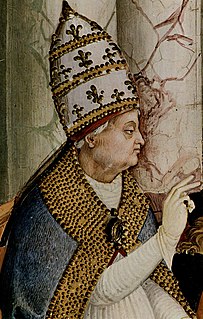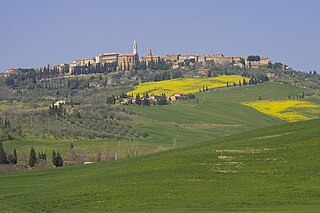
Pienza, a town and comune in the province of Siena, in the Val d'Orcia in Tuscany, between the towns of Montepulciano and Montalcino, is the "touchstone of Renaissance urbanism."

Piazza della Signoria is an L-shaped square in front of the Palazzo Vecchio in Florence, Italy. It was named after the Palazzo della Signoria, also called Palazzo Vecchio. It is the main point of the origin and history of the Florentine Republic and still maintains its reputation as the political focus of the city. It is the meeting place of Florentines as well as the numerous tourists, located near Palazzo Vecchio and Piazza del Duomo and gateway to Uffizi Gallery.

The Palazzo Chigi-Saracini is a Gothic urban palace on the Via di Città in the Terzo di Città in central Siena, Tuscany, Italy. In 2014 it housed the Accademia Musicale Chigiana.

The Pinacoteca Nazionale is a national museum in Siena, Tuscany, Italy. Inaugurated in 1932, it houses especially late medieval and Renaissance paintings from Italian artists. It is housed in the Brigidi and Buonsignori palaces in the city's center: the former, built in the 14th century, it is traditionally identified as the Pannocchieschi family's residence. The Palazzo Bichi-Buonsignori, although built in the 15th century, has a 19th-century neo-medieval façade based on the city's Palazzo Pubblico.
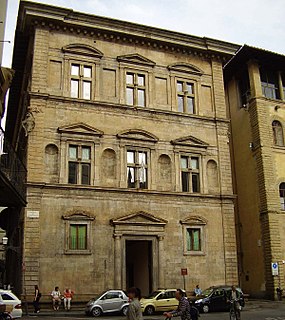
The Palazzo Bartolini Salimbeni is a High Renaissance-style palace located on Via de Tornabuoni on Piazza Trinita in central Florence, Tuscany, Italy.

Palazzo Salimbeni is a Gothic style urban palace located on the Piazza Salimbeni, just off Via Banchi di Sopra in the Terzo di Camollia of the city of Siena, region of Tuscany, Italy. The building, associated with an ancient mercantile family of Siena, currently houses the main offices of the Banca Monte dei Paschi di Siena, one of the oldest banks in the world.

The Palazzo Tolomei is an imposing, Gothic style urban palace, located on Via Banchi di Sopra in the present contrada of Civetta, Terzo di Camollia of the city of Siena, region of Tuscany, Italy.

The Palazzo Bichi Ruspoli, or previously Palazzo or Castellare dei Rossi, is an urban palace, located on Via Banchi di Sopra in the present contrada of Civetta, Terzo di Camollia of the city of Siena, region of Tuscany, Italy.

The Palazzo Spannocchi is a Renaissance style urban palace located on the Piazza Salimbeni, just off Via Banchi di Sopra in the Terzo di Camollia of the city of Siena, region of Tuscany, Italy. The building was associated with an ancient mercantile family of Siena.

The Loggia del Papa is a 15th-century Renaissance architecture, open-air arcade in Piazza of the same name in Siena, region of Tuscany, Italy.
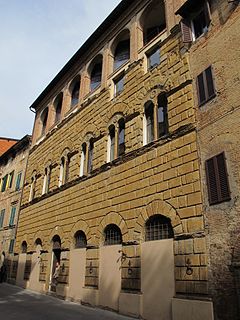
The Palazzo San Galgano is a Renaissance style urban palace located on via Roma number 47, in Terzo Camollia of the city of Siena, region of Tuscany, Italy. The palace is around the corner from the church of San Raimondo.
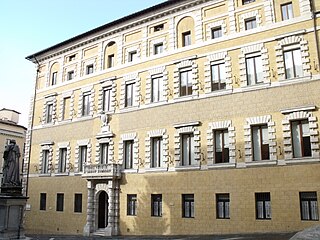
The Palazzo Tantucci is a Renaissance style urban palace localized on Via dei Montanini, on the Piazza Salimbeni, in the Terzo di Camollia, in the city of Siena, region of Tuscany, Italy. To the palace's right is the Gothic facade of the Palazzo Salimbeni, and across the Piazza with Sallustio Bandini's statue is the Classic Renaissance facade of the Palazzo Spannocchi. All three palaces are owned now by the Monte dei Paschi di Siena, one of the oldest banks in Europe, which arose in the Salimbeni palace.

The Palazzo Marsili Libelli is a Gothic style urban palace localized on Via di Città #136-142, in the Terzo di Città, in the city of Siena, region of Tuscany, Italy. The palace is adjacent to the taller Palazzo Marsili with a crenellated roofline and mullioned second and third story windows, and which stands at the corner of Via di Città and Via del Castoro.

The Palazzo Chigi all Postierla, but sometimes referred also to as Chigi-Piccolomini or Piccolomini-Adami is a Renaissance style urban palace localized on Via del Capitano #1, corner Piazza Postierla, in the Terzo di Città, in the city of Siena, region of Tuscany, Italy. The palace is up the street from the Palazzo del Capitano del Popolo, Siena.

The Palazzo del Capitano del Popolo is a 13th-century Gothic style, brick and stone, urban palace located on via del Capitano, #13-19 in the city of Siena, region of Tuscany, Italy. The name derives because it was once home of the Capitano della Guerra or Capitano del Popolo, who served as the main official for the Republic. The Palazzo is just off the Piazza of the Duomo.
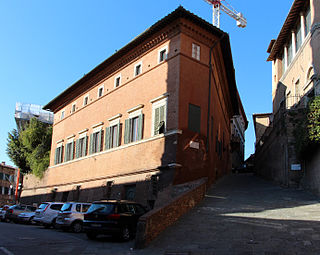
The Palazzo Celsi Pollini, once also called the Palazzo del Vescovo, is a Renaissance style urban palace in Siena, Italy. It is located on Pian dei Mantellini #39-41, at the corner with Via San Quirico. A 19th-century source refers to the house as Casa Campioni. The main facade faces the campanile of San Niccolò del Carmine.

The Palazzo Bandini-Piccolomini is a Renaissance style urban palace located on via Sallustio Bandini #32, corner Via San Vigilio in the city of Siena, region of Tuscany. It is across the street from the rear facade of the Castellare degli Ugurghieri. The palace was constructed circa 1460, and the design has been attributed to Cecco di Giorgio. The priest and proto-economist Sallustio Bandini was born in the house. The facade is mainly brick. The portal and window mouldings are made of grey pietra serena and has a Piccolomini shield with 5 crescent moons. The portal also has images of children astride dolphins. The second story windows have triangular pediments. The small interior courtyard has a well. The iron rings on the facade were formerly used to tie up horses. The property is owned by the University of Siena.
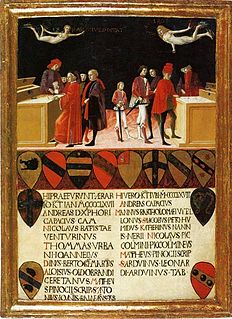
The Biccherna was the magistrate or chancellery of Finance from the 13th to the 14th century for the republic and then city of Siena, region of Tuscany, Italy.
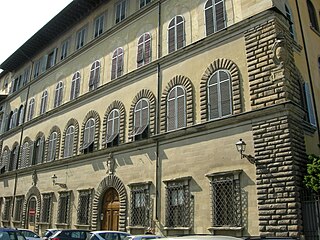
The Palazzo Torrigiani Del Nero is a Renaissance-style palace located at Piazza de' Mozzi 5, down the street where the Ponte alle Grazie enters the Oltrarno in Florence, Tuscany, Italy. Another Palazzo Torrigiani stands alongside, the smaller Palazzo Nasi. Both palaces also once belonged to the Nasi.





